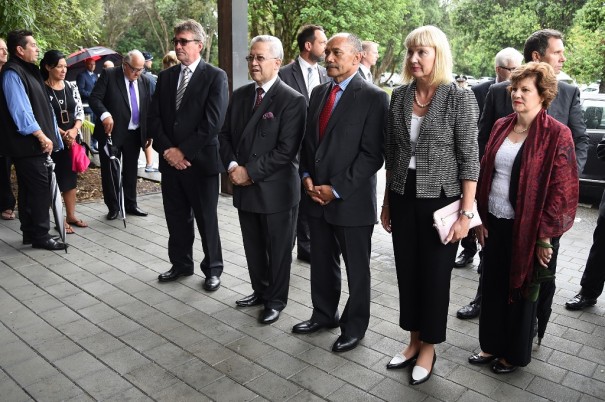Opening of Te Kōngahu- Museum of Waitangi

Tihei mauri ora.
Hoatu te mana ki a rātou kua tae mai nei ki tēnei whenua, kua wheturangitia i te korowai o Ranginui, kua hangaia i tēnei tikanga hoki. Na reira, ki te hunga kua wehe, ki tua o Paerau - moe mai i roto i te Ariki.
E aku rangatira e pae nei - Māori, Pākehā - tēnei aku mihi māhana ki a koutou.
We give credit and recognition to those who came to this land, to those who have departed and are adorned as stars in the heavens, and to those who built this tikanga. I also acknowledge all those who have passed on and who rest with God.
Distinguished guests – Maori and Pākehā – who are gathered here today, I extend a warm greeting to you all.
I specifically acknowledge: Hon Steven Joyce, Minister of Economic Development; Hon Maggie Barry, Minister for Arts, Culture and Heritage; Pita Paraone, Chair of the Waitangi National Trust Board and Board Members; and Greg McManus, Chief Executive of the Trust - tēnā koutou katoa.
It is a great pleasure for Janine and me to be here today.
Over the past four and a half years, we have visited almost every region in the country – but Waitangi is the one place that we have returned to every year.
This is where the Crown and Māori forged momentous and lasting connections. It’s where two very different cultures came together to make a pact about how they were to live together, side by side.
Whatever the disappointments and troubles that followed in subsequent years, as the name of this building – Te Kōngahu – conveys, Waitangi is where our partnership began – and where the course of its future will continue to play out.
My own connections to the Treaty are twofold: first, I am here as the Queen of New Zealand’s representative; and secondly, I am here as a descendant of a signatory – Te Hapuku - who signed the Treaty in Hawkes Bay in June 1840.
This gives me, like some other New Zealanders, a unique perspective. During my term as Governor-General, I have visited as many places as I can where the Treaty was signed to get a better sense of what our predecessors did. This week I was in Kaitaia.
These visits have deepened my appreciation of the role of the Treaty, both in our history, and in the future of our country.
Looking back to 1840, I can well imagine the challenges for Captain William Hobson and his advisers in preparing a draft Treaty. I can also understand the anxious anticipation of Māori who were gathering here 176 years ago to debate the wisdom of entering a Treaty, as they tried to imagine what the provisions of the Treaty might mean for them.
I can appreciate the dismay of my predecessor, Lord Bledisloe, when he saw the state of the Treaty House in 1932. And I salute him for determining there and then that our premier heritage site needed to be secured for New Zealanders, for posterity.
I recall the famous photograph of Sir Apirana Ngata leading a stirring haka in front of the new whare runanga in 1940; and I reflect on all the thousands of New Zealanders, from all walks of life, and all political persuasions, whose feet have trod a path to the Treaty Grounds.
Giving visitors to Waitangi the opportunity to learn about why all those people have come here is a good thing.
I very much share the Waitangi National Trust Board’s ambition to broaden New Zealanders’ understanding of the context and subsequent history of our founding document – including up to the present day.
My hope is that this will become a place every New Zealander, whatever their origins, sets out to visit. I say this because understanding of the Treaty is central to citizenship of New Zealand.
There was a time when there was wilful ignorance about the Treaty. Thankfully, legislatively and otherwise, knowledge and understanding of Treaty principles have become more mainstream.
There is a whakatauki that sums up the benefits that accrue to us from learning: “Whāia te mātauranga hei oranga mo koutou – Pursue learning for the sake of your wellbeing”.
Te Kōngahu will help people learn about the Treaty. It will take the Waitangi experience to a new level. It will help visitors understand why Māori have sought redress. And that understanding will be good for all New Zealanders as we go forward.
I very much enjoyed my sneak preview. As well as seeing all the interpretation and displays, I wanted to see the magnificent painting of Queen Victoria, which for some years was hung in the ballroom at Government House Wellington.
We were delighted to look after her at Government House – and although we were sad to see her go, we are also pleased that the Trust now has an appropriate building to house it and other tāonga associated with the Treaty and the history of Māori/Pākehā relations.
And while we’re here, Janine and I have checked the pohutukawa we planted last year in these grounds. It is flourishing, which I’d like to think is due to the particular care and expertise displayed when it was planted!
Congratulations to everyone associated with the Waitangi museum project. It’s a fantastic milestone for the Waitangi National Trust.
I wish the Trust and everyone associated with Te Kōngahu all the very best with this magnificent new facility.
Kia ora huihui tātou katoa
